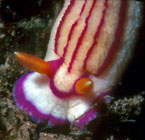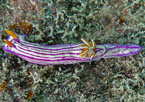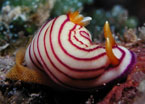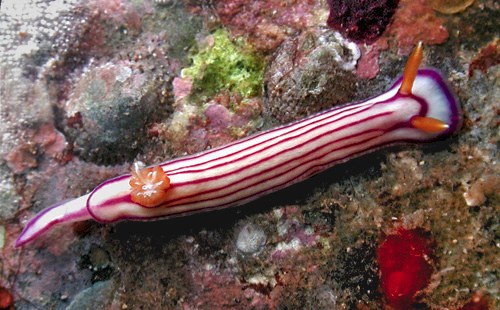| Home |
| Acknowledgments |
| Conventions |
| Glossary |
| Maps |
| References |
| Links |
| Articles |
| Thumbnails |
| Species
list |
| Family |
| Next
species |
Additional Photos

side

rhinophores

branchia

flecked

laying eggs

Hypselodoris maridadilus Rudman, 1977

| Maximum size: 34 mm (Bertsch
and Johnson, 1981); about 50 mm for flecked animal. Identification: This species has a bright-white body with five longitudinal purple-pink lines on the notum and a purple-pink line on the margin of the mantle. The rhinophores are orange with tiny white tips and the gills are orange with white on the upper edges. Some animals may have flecks between the lines. Natural history: Hypselodoris maridadilus is a moderately rare species in the main islands but is commonly seen at Midway Atoll. It is found in moderately protected locations on rocky bottoms and patch reefs at depths of < 1 to 20 m (< 3 to 65 ft). It lays an orange egg mass. Distribution: Maui, Oahu, Lisianski and Midway: widely distributed in the Indo-Pacific. Taxonomic notes: Some authors consider the Hawaiian population to be Hypselodoris whitei (Adams & Reeve, 1850) rather than H. maridadilus (restricting the latter to the Indian Ocean). See the See Slug Forum for further discussion. Described from East Africa, its scientific name comes from the Swahili word "maridadi" which means "beautiful." It's referred to as the "magenta-striped nudibranch" in Hoover, 1998 & 2006. It was probably first reported from Hawaii in Eydoux and Souleyet, 1852 (as Doris lineata). (Note 1) Photo: PF: 29 mm: Napili Bay, Maui; Aug. 19, 1994. Observations and comments: Note 1: The only photo we've seen with a lighter color and flecks between the lines was from Midway. (see photo) However, the photo of H. maridadilus in Gosliner, et. al. (2018) shows a typical color pattern and is also from Midway. Whether the flecked form is restricted to Midway or we just haven't found it elsewhere due to the small sample size is unknown. There's some possibility that it could be distinct but rhinophore color, branchia color and the basic pattern of the lines are the same. That argues for lumping (pending DNA work...). Or, perhaps the flecks develop with age since the recent Midway animal was very large for the species? |
| Thumbnails |
Species
list |
Family | Next species | Top |